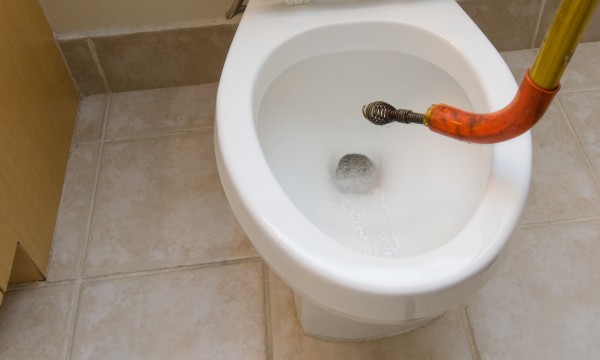Time: 10-30 minutes
Frequency: As required
Difficulty: Easy
Tools: Plunger, plumber’s snake, nonchemical drain cleaner
- Browse Categories
- All Tips
-
Home & Garden
- All
- Appliances
- Bathroom
- Cleaning
- Crafts
- Decorating
- Electrical
- Flooring
- Furniture
- Garage Door
- Gardening
- Green Living
- Heating
- Home Alarm Systems
- Home Maintenance
- Home Remedies
- Home Security
- Home Staging
- House Sitting
- Junk Removal
- Kitchen
- Lawn Care
- Lock Systems
- Moving
- Outdoor Living
- Pest Control
- Plumbing
- Renovation
- Roofing
- Snow Removal
- Storage
- Tools
- Tree Service
- Health
- Family
- Travel
- Auto
- More Tips

Surefire tips to unblock a clogged drain using a plumber’s snake
April 20, 2017

If your drain is overflowing, your toilet is flushing slowly, or you’re hearing odd gurgling sounds coming from your sink, chances are you’ve got a clogged drain. While clogs can be unpleasant, you can usually avoid an overly messy job with proper care and attention: go slowly and be sure to minimize your interaction with what’s blocking the drain.
If cleaning solutions and plunging aren’t getting the job done, there are a few plumbing snake tricks you can try to loosen the debris and get things moving again before calling in a plumber for help. [Photo credit: istock.com/spates]
Step 1: Start with a drain cleaner
It’s best to avoid chemical drain cleaners as they can corrode and damage pipes, leading to a bigger problem than a clogged drain. For a gentler approach try:
- Baking soda and vinegar: Empty as much water from the toilet or sink as you can, pour in a half-box of baking soda, then slowly pour in the vinegar. Let sit for 30 minutes and then carefully pour in hot water.
- Dish soap and hot water: Pour a small amount of dish soap into the drain and let it sit, then follow with hot (not boiling) water to break down the clog.
Following either method, if the hot water drains, the clog is likely fixed. If not, you can repeat again or move on to the plunging.
Step 2: Try a plunger
Before moving on to a plumber’s snake, you can try breaking up the clog with a basic plunger.
- For best results on toilets, select an extended flange plunger. Cup plungers are great for sinks and drains on flat surfaces, but if you can fold in the flange of the toilet plunger to create a bell, you can increase your plunging power.
- The first plunge in a toilet gets rid of the air and fills the plunger with water so you can get water pressure flowing to remove the blockage.
- Before plunging sinks and showers, make sure to block the overflow hole first and fill the sink or shower with some water.
- Plunge rapidly up and down and then take the plunger off the drain. Do this until you can dislodge the blockage.
Good to know!
Most toilet obstructions actually occur in the toilet’s colon, which is easier to unclog than the drain itself.
Step 3: Use a plumber’s snake
If the plunger didn’t work, then it’s time to up the ante with a plumber’s snake, also known as a drain auger.
- There are different kinds of plumber's snakes, so make sure you’re using the right one for the task at hand: toilet augers for toilets, drain pipe augers for the small pipes of sinks, and machine augers to make quick work of larger jobs.
- The drain auger has a thin, steel coil at the end that can grab and move drain obstructions more efficiently than a drain cleaner or plunger.
- Place the working end of the auger at the drain opening and hand-crank the auger clockwise as you feed it into the opening.
- There may be some resistance, but keep going. You’ll notice when you hit the obstruction because the auger will move more slowly or become difficult to feed in.
- Once you’ve hit the obstruction, move the auger forward and backward while still twisting to loosen or break up the clog. This could take a few minutes.
- Once you’ve successfully moved through the obstruction, pull the auger up slowly and carefully to avoid any messes.
- Run the water for a few minutes so the drain can fully clear out the rest of the clog.
Good to know!
With electric augers, you can use the automatic feed feature after placing the end of the auger into the drain opening. Remember to retract the auger slowly when you’ve located the blockage.
Now that you’ve managed to unblock your pipe, preventative measures can go a long way to keeping things draining smoothly. Keep toilets covered to stop items from accidentally falling in, and try not to flush excessive amounts of toilet paper. Drains are also best left to water; grease or other hardening agents should be disposed of in the garbage. If things do get backed up again, learning how to snake a drain properly could save you the expense of calling in a professional plumber.






